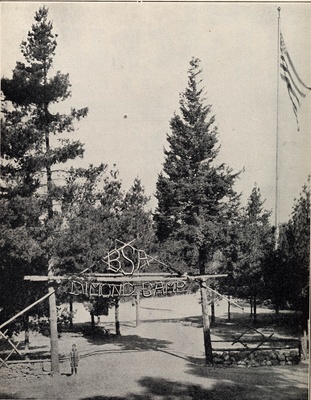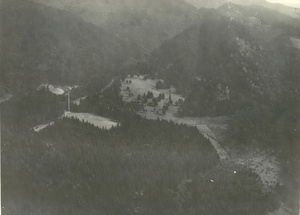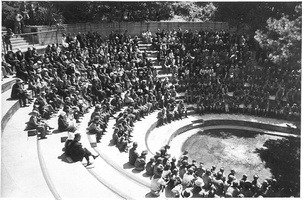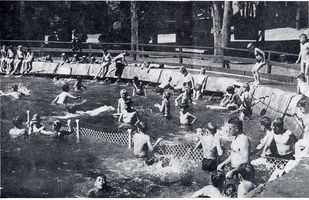 Camp Dimond Entrance (across from Mountaingate Dr @ Ascot Dr)
Camp Dimond Entrance (across from Mountaingate Dr @ Ascot Dr)
 1923 Aerial view of Camp Dimond. Location of Flag Pole is where Montera main office is located.
1923 Aerial view of Camp Dimond. Location of Flag Pole is where Montera main office is located.
Photos
 1937 Camp Dimond Parade Grounds facing Ascot Rd. House on left is still there at Mountain Gate and Ascot
1937 Camp Dimond Parade Grounds facing Ascot Rd. House on left is still there at Mountain Gate and Ascot 1925 Camp Dimond Amphitheater
1925 Camp Dimond Amphitheater Camp Dimond Pool (300,000 gallons) non-swimmers at top of image, swimmers at bottom of image
Camp Dimond Pool (300,000 gallons) non-swimmers at top of image, swimmers at bottom of image
Maps
 1933 Oakland street map. Camp Dimond shaded in pink
1933 Oakland street map. Camp Dimond shaded in pink 1932 Map of Camp Dimond
1932 Map of Camp Dimond 1945 Camp Dimond site layout
1945 Camp Dimond site layout
The text below is derived from the Boy Scouts' San Francisco Bay Area Council History site. The site also has a number of pictures of the camp.
Camp Dimond History
In 1820, Luis Maria Peralta who was a long time soldier in the Spanish Army received one of the largest Spanish Land grants when all of the land from El Cerrito to San Leandro, including the area that would become known as Dimond Canyon, was given to Peralta for his years of service. Although Peralta never lived on his property he divided the land amongst his four sons in 1842 with Antonio Peralta receiving the section of land that included the Canyon.
In 1867 Hugh Dimond, who had made his fortune in the mercantile and liquor trades during the Gold Rush, purchased the canyon section and some adjoining land from Antonio Peralta. The land that he owned became known as Dimond Canyon and the lower section became known as the Dimond district of Oakland.
F.M. Smith Reserve
Hugh Dimond died in 1896 and his son sold 474 acres of the land at the upper end of Dimond Canyon to Francis Marion Smith in 1907. FM Smith as he was known made his fortune mining Borax and was known as the Borax king. Smith was also involved in real estate and owned the Key System street car lines of the East Bay. The swath of land at the top of Dimond Canyon that Smith now owned was called the FM Smith Reserve and included two creeks where Smith could hunt and have picnics. Smith had planned to build his country estate on the property. The crest of the property also afforded Smith unobstructed views of Downtown Oakland as well as his own Smith Estate (known as Arbor Villa) which was located two blocks south of Park Boulevard near the present day location of Oakland High School. However by 1913 Smith over-extended himself due to short-term borrowing and had gone into bankruptcy. He was forced to turn over his assets to creditors who refused to extend the loans.
The first camping by the Boy Scouts on the property actually took place only one year after the Boy Scouts of America was officially organized in 1910. A small group of Scouts from both Oakland and San Francisco which had recently disassociated themselves with the American Boy Scouts and became associated with the Boy Scouts of America, camped on the Smith Reserve in March of 1911. Although it would be five more years until Oakland and San Francisco would officially organize their respective councils (and 53 years until the two council merged), this was the first combined outing of the future Scout Councils. According to the Oakland Tribune, each scout on the weekend campout, was outfitted with a "Billy," which consisted of a tin bucket with a lid. In the bucket the scout carried a knife, cup, spoon and enough food for two days and a blanket. Army Lieutenant Edward Kendrick was in command and instructed the scouts in the ways of camp life and how to light fires and cook their food.
The area of the Smith Reserve where Camp Dimond would ultimately be located, was one mile south of the Montclair shopping village and where the present day Montera Middle School and Joaquin Miller Elementary School are currently located. The location was on a bluff at the top of the Dimond canyon and was populated by oak trees, pine trees and a large open field. The property also had a type of oak tree on the property known as Shea oaks which Smith had transplanted from Australia. Also located on the property was a large cement water tank 75’ x 75 ‘ that was fed by the waters and springs of the nearby Cobbledick Creek as well as a small nearby lake where present day Ascot Place is located. Smith Lake, which is noted on maps of the scout camp and even old city street maps, was fed by the creek and was located at the intersection of Ascot Drive and Scout Road. The lake no longer exists and most likely was filled in the late 1930s or early 1940s as the Montclair Hills were built out. Houses now occupy the location of where the lake was and the creek now goes through an underground culvert where it crosses Ascot Drive.
Camp Dimond is Acquired
In January of 1919, the Oakland Council seeking a permanent location for both a summer camp and week-end camp site was able to purchase a 28 acre section of the 474 acre Smith Reserve for $20,000 (roughly $800 per acre). This new permanent site would replace the week-end camp site that the Oakland council had used for slightly over a year that was located across the canyon at the top of the Oakmore Highlands ridge. Once the new site was acquired, the “old” weekend camp site was disassembled and the various temporary structures moved over to Dimond.
Although the name of the camp was simply Dimond, old scout records from 1920 show that Camp Dimond at one time was named “Camp Sheaoak” due to the type of oaks on the property. Since Camp Dimond was only one mile from the end of the Park Boulevard street car line, Scouts in the early years would take the street car, disembark at the end of the line near Estates Drive and hike up the trail on the north side of Dimond canyon to the camp. The camp was bounded by Scout Road, Ascot Drive and Mountain Boulevard. Sometime between 1922 and 1933, the City of Oakland renamed County Road xx to Scout Road in honor of the Boy Scouts and their Scout Camp. The main entrance to the camp was directly across from the Mountain Gate intersection with Ascot Drive. Over the camp entrance there was a large Dimond fashioned out of wood spars and lashed together.
During its first summer camp operations in June of 1919, 65 scouts used the camp. However during that first summer there were very few permanent facilities at this new camp. The 40 ft x 130 ft (5200 sqft) mess hall and commissary, which was built by the Oakland Building Trades Council, would not be constructed and used until the following year of 1920. The mess hall was built on the East side of the parade field in front of a hill lined with Oaks and Pine trees. In May of 1921, the tallest flagpole in the Bay Area at the time was installed in the parade grounds at Dimond. The flagpole was 115’ tall and the tree that was made into the pole came from Washington State. The flagpole could be seen from downtown Oakland and flew an enormous American flag that was 20’ x 30’ in size. The flag pole was donated by the National Pole company and installed by the Pacific Telephone and Telegraph Company. The flagpole crashed to the ground in December 1936 during a storm with high winds.
Earliest Eagle Scout Association Founded at Camp Dimond
The Order of the O-hit-e-kah was a an Eagle Scout Association founded at Camp Dimond in 1922 and was one of the first Eagle Associations in the entire Country. The O-hit-e-kah tribe was made up of Eagle scouts only and members of the tribe gave Eagle Scouts an opportunity to show their leadership ability not only in the work of their respective troops, but also in the service which they are rendering at Camp. The Eagle association had "tribes" in Stockton as well as New York. The Order of the O-hit-e-kah was a predecessor to the National Eagle Scout Association. In 1925 the San Francisco Council organized the Knights of Dunamis, their own Eagle Association.
As Scouting continued to grow, additional buildings and facilities were built. Until 1923, the Scouts camped in basic canvass tents that had simple wooden floors. Starting in 1923 the Oakland Rotary Club, the Oakland Kiwanis Club, the Oakland Lions Club and even the Alameda County Laundry Owners Association helped to build and construct 21 cabins to replace the tents that had been used since the camp opened. Each open-air scout cabin was approximately 18’ x 18’ and slept 8 scouts. Also in 1923, the Oakland Area Council hosted the Region 12 Scout Executive training conference at Camp Dimond for 80 Scout Executives from seven states. It was the opinion of all executives present “that Camp Dimond was the finest and best equipped training center that the group had yet visited.”
In 1924 the Oakland Area Council acquired additional land at Dimond that contained the water tank which had been excluded from the original 1919 purchase. With the addition of the water reservoir the Council now had a location that could be used for swimming. The water tank was circular and held 300,000 gallons of spring fed fresh water. Because the original use of the new swimming pool was actually a reservoir, the pool was one depth. In order to make it useable for both swimmers and non swimmers, the camp added a wooden platform that was on one side of the pool along with a fence to separate the two sides. This allowed non-swimmers the ability to use the pool. Swimming was offered in the afternoons during summer camp and on weekends. At first the pool had very basic amenities, however in time a 500 gallon hot water tank was added by the Oakland Exchange Club to support 10 shower heads in the Dimond shower room. Bleachers were added for parents to watch the swimmers and a giant sand filter was added to ensure the water stayed crystal clear. After Dimond closed, the giant sand filter tank was moved up to Rancho Los Mochos (in the hills south of Livermore) where it was used to filter the Los Mochos pool until 2013 (almost 100 years of use by our camps). Rancho Los Mochos was donated to the Oakland Scouts in 1944 by the Auto Machinist Union 1546 as a wilderness campsite in memory of the members who gave their lives in the war efforts. The Dimond pool was naturally heated by the rays of the sun.
In early 1925 ground breaking ceremonies were held for the construction of an outdoor cement amphitheater that would be used for Court of Honors, Campfires and trainings. The 1500 seat amphitheater was built with funds raised by the Oakland Exchange Club and was built in a similar design to the Greek theater at UC Berkeley.
Scouts from all over the Bay Area used Camp Dimond for many purposes. In April of 1927, a Patrol Leaders Conference was held at Dimond for both the Oakland Council and the San Francisco Council. The Oakland Board of Education had a very close relationship with the Scouts and would rent Camp Dimond on many occasions for meetings and teacher retreats. In 1937 Scouts from across the country that attended the Worlds Fair on Treasure Island camped at Dimond.
From 1933 until 1949, the council headquarters of the Oakland Area Council was located at Camp Dimond in the former first aid building that was known as the Camp Kiwanis building. By the 1940s over 3000 Scouts would be using Camp Dimond throughout the year for their various outings, functions, meetings, Court of Honors and Father-Son dinners. In 1943, the mortgage note to Camp Dimond was paid off making the camp fully owned by the Oakland Council of the Boy Scouts of America. In October of 1947 the Order of the Arrow (Machek N'Gult Lodge 375) was established in the Oakland Council when ceremonies were held in the mess hall at Camp Dimond.
Oakland Board of Education Seeks to Condemn Dimond
As the population of Oakland grew so did the need for additional schools. This was especially true in the hills of Montclair where new house construction was creating the need for two new schools. The residents of Oakland saw this need and passed a $15M bond measure in 1945 which also included money for the construction of new schools. When the bond measure passed, the Oakland Board of Education started looking at various sites in the hill area for the location of a new school but kept coming back to the land that the Boys Scouts owned. The site of Camp Dimond was centrally located, was accessible by bus, had enough acreage and for the most part was level. Everything the Board of Education needed, EXCEPT, that they did not own the land.
In October of 1947 the Oakland Board of Education in a letter to the executive board of the Oakland Area Council indicated that they required the Camp Dimond property and would take ANY necessary steps to acquire the land. At the time Scout Executive Homer Bemiss indicated he would not stand in the way of the Board of Education. However in a letter of response from the Oakland Executive Board to the Board of Education their response was a resounding 'No.'
Although the Scouts initially indicated No, other issues also working against the Scouts was the fact that the City of Oakland was improving the streets and adding sewer lines to that area of town. The Dimond property had approximately 3000 feet of frontage along the streets to be upgraded. The City of Oakland would assess a value to the Scouts based on the amount of street frontage as well as the connection fee to the new sewer lines. These fees alone would ran into the tens of thousands of dollars.
The City of Oakland and the Oakland Board of Education started the condemnation process to condemn the property in order to take possession of the Scout property. The Oakland Area Council did not have the power to stop this condemnation process and ultimately had to sell the property to the Oakland Public Schools in 1948.
Letter to the Editor of the Oakland Tribune - December 13, 1947
“We the Scouts and leaders of Troop 54 of Crocker Highlands School, are opposed to the action of the Board of Education in ordering condemnation proceeding to take our Scout Camp from us. Many of us as well as our parents and friends contributed generously four years ago to pay off the mortgage of the camp so that the camp may be enjoyed by the Scouts and the Cub Scouts of Oakland. If this camp with all its facilities including the swimming pool, craft shop, nature den, cooking areas, cabins, amphitheater and mess hall are taken away from us, the scout program in Oakland will never be the same. Most of the Scout program is built around the camp from which Scouts and Scout Leaders from all over Oakland can reach in a very short time by automobile, bus, by streetcar or by hiking.
We feel that the overwhelming majority of Scouts, Scout leaders and all citizens of Oakland feel the same way and that we believe that everyone should have the opportunity to express their view so Camp Dimond can be saved for the Scouts and future Scouts. Let the Board of Education select another site for their proposed school.”
Camp Dimond Closes
On August 10, 1948 at the end of its regular summer camping season and 29 years after it opened, Camp Dimond had its final campfire and closed its doors forever to camping. The 5200 sq foot mess hall would still be used for another six months for meetings and scout gatherings until it was torn down in early 1949. The office headquarters of the Oakland Council which was located in the Camp Kiwanis building remained in place until June 1949, but the process of closing Dimond for good had started. The equipment and supplies from Dimond were moved into temporary storage at Camp Shoemaker on the grounds of Camp Parks in Dublin as well as Camp Meek in San Lorenzo.
In January of 1949 the 5200 square foot mess hall and each of the twenty-one Scout Cabins built in 1923 by the Troops, the Rotary Club and the Kiwanis Club were put up for sale for any perspective buyer. However before the Mess Hall was torn down, the properties committee of the Oakland Council used the interior of the building to construct forms for the new pool up at Los Mochos. On March 1, 1949 the Oakland Public Schools took physical possession of Camp Dimond from the Boy Scouts and in June grading began as the former camp site was cleared and flattened in preparation for the two new schools. Two years after Camp Dimond closed, Joaquin Miller Elementary school would open its’ doors in September of 1950 on the grounds of the former camp leaving only Dimond-O (near Yosemite) as the sole summer camp for the Oakland Area Council. In May of 1949, the Oakland Public Schools provided the Scouts with some temporary space at the Garfield Elementary School that was used as their headquarters until a permanent space was built in the Clinton district of Oakland at 655 E14th Street. The office location on E14th was used from 1951 until 1974 when a larger Council Office was constructed at 8480 Enterprise Way, near the Coliseum.
Camp Dimond Remnants
Although Camp Dimond has been gone for over sixty years, portions of the camp can still be found today with a little investigation. The giant sand filter tanks that once ensured clean water for the 300,000 gallon round swimming pool was moved up to Rancho Los Mochos in 1949 where it continued to filter the Los Mochos pool for many more years. In 2013 the filter tank was in dire need of replacement after 88 years of use at both Camp Dimond and Los Mochos. The Camp Kiwanis building which was used as the first aid building and then as the Council Office from 1933 until 1949 was cut into three sections and moved up to Los Mochos for use as the Ranger’s cabin. The building still exists today highly modified, but still intact.
In 1953 the Lake Merritt Nature Center was built through funds donated by the Oakland Rotary Club and the Oakland Scouts. The scouts had setup a memorial fund in honor of their longtime naturalist for the Oakland Area Council Brython “Bugs” Cain. Inside the Nature Center in the B. C. Cain Library are some of Cain’s Camp Dimond bug collection that were once located in the famed nature hut, also known as the “Bug House”, The collection was first moved to the former Camp Meek scout property in San Lorenzo and eventually the collection was moved to the Lake Merritt nature center. A totem pole very similar in appearance to the the large Camp Dimond totem poles built by Ed Taylor in the 1930s is located at the entrance to the Nature Center. Although built by a modern day craftsman, the pole harks back to the years when Ed carved the poles at Dimond.
In the summer of 2008, I had the opportunity to explore the old grounds at Camp Dimond and was able to find a few areas of the camp that still remained. The cement piers that once supported the back deck of the large amphitheater stage are still in place on the hillside, although massive trees were now growing between their columns. Cement beams that appear to have been used as the seats for the amphitheater can be found near the rear parking lot entrance at Scout Road. A section of the stage as well as portions of the Indian Village could still be found including pieces of a metal cot, overgrown power lines in the trees and a rusted tank that may have been used for water storage. The hill behind the camp mess hall which was known as the "Eagles Nest" was flattened to provide the fill material necessary to create the rear parking lot and the back entrance from Scout Road. Camp Dimond was the premier Scout Camp in the Bay Area that attracted campers from as far South as Los Angeles. Although the camp is gone, the history of the camp lives on in the memories of the many Scouts and Scouters that once camped on its grounds.
Video



